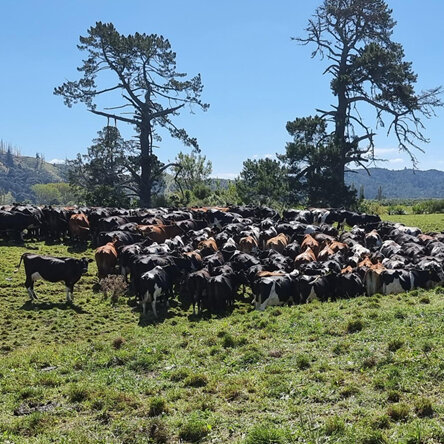Franklin Vets
Franklin Vets - excellence in veterinary care for dairy, farming, lifestyle, equine and household pets. BESTPRACTICE ACCREDITED NZ.

Well if animal comfort and welfare is not enough for you, it has a huge effect on milk production and can contribute to diseases like lameness and impact reproduction performance. So even those with a one tract business mind should be interested. So what can you do?
Drinking water is a given. My dad always used to say to me “Amber, milk is close to 90% water so a farmer's one job is to make sure the cows have water” and he's not wrong, but how much? During hot summer days, cows can drink close to 100 L of water a day each! So it's important to make sure we have water, have enough of it and have enough troughs/space so that everyone can have a turn.
Wetting the yard down before the cows come on to it for milking. There are two benefits here. The first thing is that it takes away a lot of the heat from the concrete. The second is that it's easier to wash down at the end! Two birds with one stone!
Sprinklers in the yard. I know what you are going to say, but Amber this costs! I know for certain based on my last trip to Bunnings that sprinklers are going to cost you an arm and a leg but if that or time is an issue there are some alternatives. Within the first 10 min of the cows coming into the yard, you could gently hose them down. The most important thing is to try not to wet the udder or directly spray the ears. The other thing is you want to try and thoroughly wet the cows down, because unfortunately, just a sprinkle is not going to do the job!
Sprinklers in the shed. The last farmer I talked to said this was 100% worth it regardless of the money he spent as he now hates afternoon milkings less.
On hot days try to reduce the walking distance and the speed at which the cows are walking to the shed. This also has a two-bird effect as it can help with lameness.
Allow extra yard space, particularly in uncovered yards. This is a long-winded way of saying be nice with your good friend the backing gate (This also helps with lameness).
Consider milking times. This is much harder on larger-scale farms with staff but it could be a good option to make milking times earlier in the morning or later in the afternoon. Or you could just go on OAD altogether and knock off for that much-deserved cold beer earlier!
Have a look at your cow flow and milking efficiency. Getting those cows out of the shed sooner reduces heat stress, gets you home sooner and even helps with mastitis! Have a chat with your friendly vet if this is something that interests you.
Increasing the daily allowance in the morning or overnight. Two things for this, the first is that your cows will naturally eat more during the cooler times of the day so it makes sense to feed them more during these times. The other side to this is that rumination after eating produces heat so feeding less during this time will help keep body temperatures down.
However, I want to preface the previous point that what you should be feeding during the day should be higher in metabolisable energy and lower in fibre. For example, feed your PKE or meal during the day over your hay or silage as it has less fermentation time in the rumen and therefore produces less heat.
Providing salt licks. Why? Well, naturally when you go for a run (not me but others) you sweat a lot and need to replenish that sodium, potassium and magnesium. Similarly, on hot days cows can lose these minerals by sweating so providing a salt lick is a nice easy way to counteract that.
Cows naturally seek shade when they are hot during the day so strategically using paddocks with trees on hot days can be an easy way to help reduce heat stress. Don't have trees? Maybe it's worth considering planting some, there are plenty of local funds to get some trees planted and kids always need pocket money!
For those that are really keen! This is more on the pricier side but if you were thinking of putting up shade cloths, make sure to put up cloths with 80% shade for the best bang for your buck! If you were wondering where to put, over your feed pad or yard would be a good place to start.
If you have any more good or simple ideas that I may have missed please don’t hesitate to let me or your local vet know! We are always looking for tips and tricks to pass on to other farmers! Otherwise, enjoy the rest of your summer!
Dr Amber Rowan-Sanders BVSc Farm Vet, Taupiri